Nonoptical Astronomy
Looking back at Figure 3-6, you can see that visible light represents a very tiny fraction of the electromagnetic spectrum. As late as the 1940s, astronomers had no idea how much nonvisible radiation is emitted by objects in space. However, today we know that many objects in space emit undetectable amounts of visible light, but release large amounts of nonvisible radiation. Specially designed telescopes gather electromagnetic energy in all of the nonvisible parts of the spectrum. From the radio waves and infrared radiation being emitted by vast interstellar gas clouds to the ultraviolet radiation and X-rays from the remnants of stars to bursts of gamma rays of extraordinary power from merging black holes and other sources, our growing ability to see the entire electromagnetic spectrum is revealing intriguing phenomena. To get a sense of how much we do not see in the visible part of the spectrum, look at Figure 3-32, which shows visible, ultraviolet, and infrared images of the familiar constellation Orion.
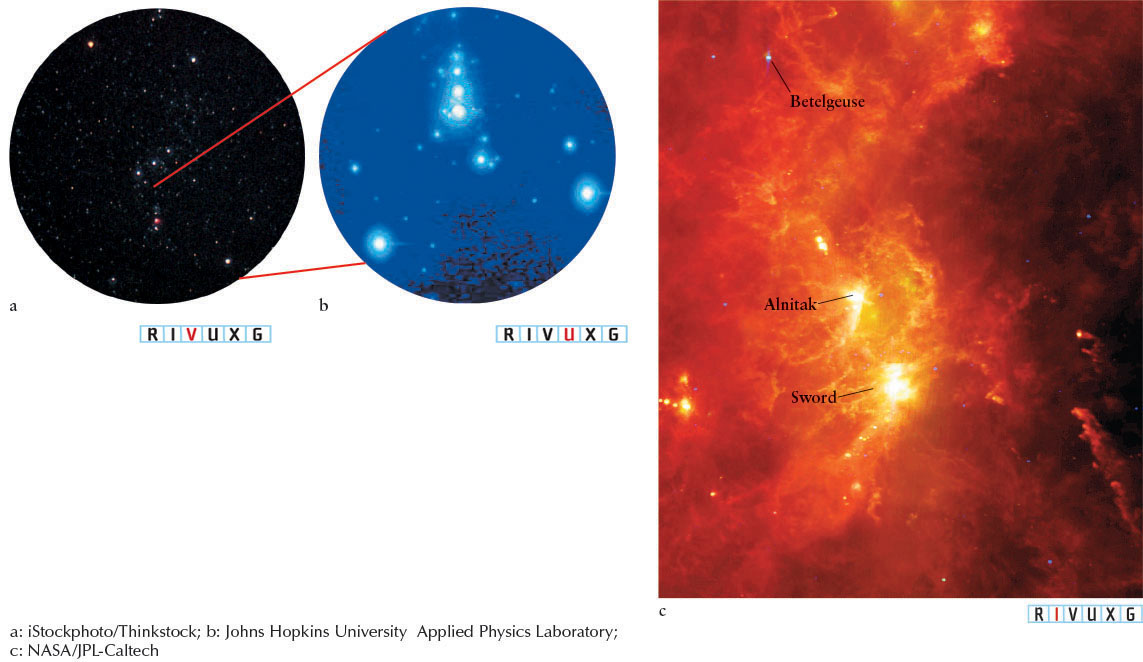
3-14 A radio telescope uses a large concave dish to collect radio waves
The first evidence of nonvisible radiation from outer space came from the work of a young radio engineer, Karl Jansky (1905–1950), at Bell Laboratories. Using radio antennas, Jansky was investigating the sources of static that affect short-wavelength radiotelephone communication. In 1932, he realized that a certain kind of radio noise is strongest when the constellation Sagittarius is high in the sky. Because the center of our Milky Way Galaxy is located in the direction of Sagittarius, Jansky correctly concluded that he was detecting radio waves from elsewhere in the Galaxy. Jansky’s accidental discovery of radio signals from space led to a worldwide effort to “see” what nonvisible wavelengths could teach us about the cosmos.
Insight Into Science: Think “Outside the Box”
Observations and experiments often require making connections between seemingly unrelated concepts. Jansky’s proposal that some radio waves originate in space is an example of connecting apparently disparate fields—astronomy and radio engineering.
Radio telescopes record radio signals from the sky. Just as a mirror reflects visible light, the metal surfaces of radio telescopes reflect radio waves. Each radio telescope has a large concave dish (Figure 3-33) that focuses radio photons in the same way that an optical telescope mirror focuses visible photons. A small antenna tuned to the desired wavelength is located at the telescope’s prime focus or Cassegrain focus. The incoming signal is relayed to amplifiers and recording instruments.
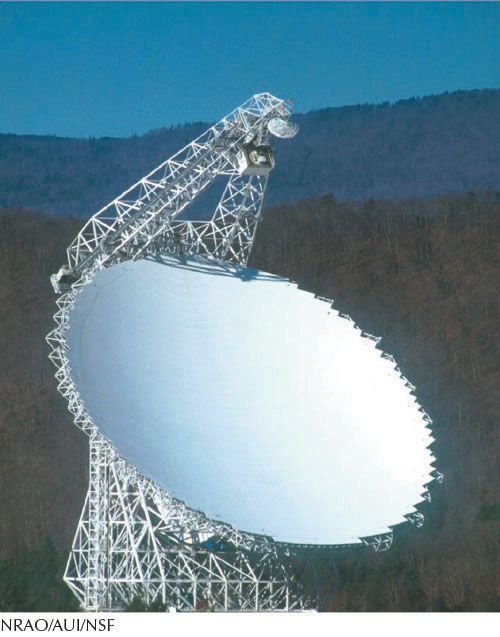
Radio waves have the longest wavelengths of all electromagnetic radiation. Because the angular resolution of any telescope decreases as the wavelengths it collects increases, a radio telescope gives a fuzzier picture than any other type of telescope with the same diameter. Indeed, the first small radio telescopes produced blurry, indistinct images.
93
 Very large radio telescopes create sharper radio images because, as with optical telescopes, the bigger the dish, the better the angular resolution. For this reason, most modern radio telescopes have reflectors more than 25 m in diameter. Nevertheless, even the largest radio dish in existence (305-m-diameter in Arecibo, Puerto Rico) cannot come close to the resolution of the best optical telescopes. For example, a 6-m optical telescope has 2000 times better resolution than a 6-m radio telescope that detects radio waves of 1-mm wavelength.
Very large radio telescopes create sharper radio images because, as with optical telescopes, the bigger the dish, the better the angular resolution. For this reason, most modern radio telescopes have reflectors more than 25 m in diameter. Nevertheless, even the largest radio dish in existence (305-m-diameter in Arecibo, Puerto Rico) cannot come close to the resolution of the best optical telescopes. For example, a 6-m optical telescope has 2000 times better resolution than a 6-m radio telescope that detects radio waves of 1-mm wavelength.
To overcome the limitation on resolution set by telescope diameter, radio astronomers often use interferometry to produce high-resolution radio images. Recall from Section 3-13 that interferometry combines the data received simultaneously by two or more telescopes. The telescopes can be kilometers, continents, or even worlds apart. The radio signals received by all of the dishes are made to “interfere,” or blend together, and, with suitable computer-aided processing, the combined image of the source is sharp and clear. The results are impressive: The resolution of such a system is equivalent to that of one gigantic dish with a diameter equal to the distance between the farthest telescopes in the array.
Interferometry, exploited for the first time in the late 1940s, gave astronomers their first detailed views of “radio objects” in the sky. One of the most complex systems of radio telescopes used in this way began operating in 1980 on the plains of San Agustin near Socorro, New Mexico. Originally called the Very Large Array (VLA) and now upgraded and renamed the Karl G. Jansky Very Large Array, this system consists of 27 concave dishes, each 26 m (85 ft) in diameter (Figure 3-34). The 27 telescopes, which can be moved, are positioned along the three arms of a gigantic Y that can span a distance of 36 km (22 mi). Working together, they can create radio images with 0.1″ resolution. This system produces radio views of the sky with resolutions comparable to those of the best optical telescopes.
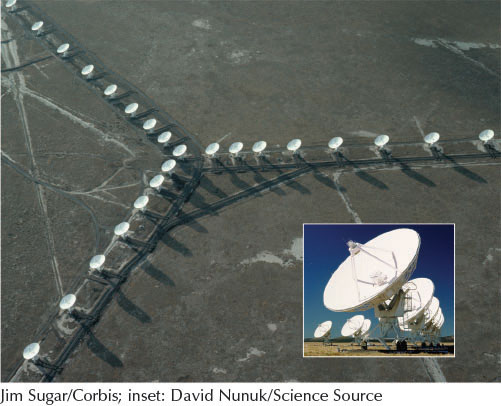
More recently, radio telescopes separated by thousands of kilometers have been linked together in very-long-baseline interferometry (VLBI). The Very Long Baseline Array (VLBA) consists of ten 25-m radio telescopes located across the United States, from Hawaii to New Hampshire. With a maximum baseline of 8000 km, VLBA has a resolving power of 0.001″.
94
The best angular resolution on Earth is obtained by combining radio data from telescopes on opposite sides of our planet. In that case, features as small as 0.00001″ can be distinguished at radio wavelengths—10,000 times sharper than the best views obtainable from single optical telescopes. Radio telescopes are also being put into space and used in even longer-baseline interferometers.
To make radio images more comprehensible, radio astronomers often use gray scales (see Figure 1-3i) or false colors (Figure 3-35). The most intense radio emission is shown in red, the least intense in blue. Intermediate colors of the rainbow represent intermediate levels of radio intensity. Black indicates that there is no detectable radio radiation. Astronomers who work at other nonvisible-wavelength ranges also frequently use false-color techniques to display views obtained from their instruments.
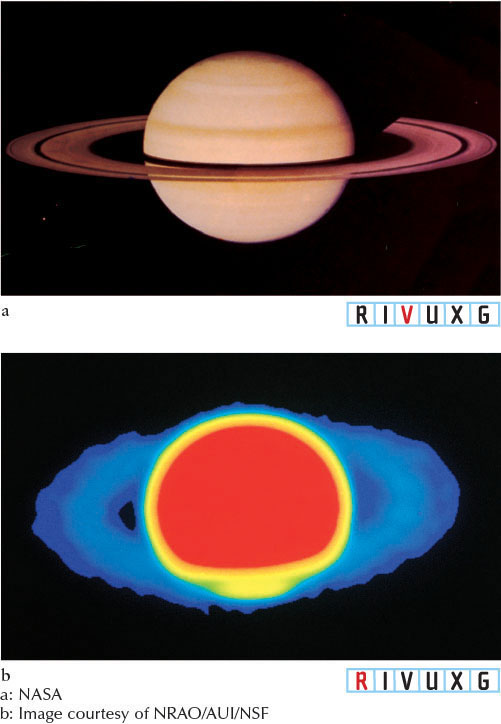
Consider an example of how nonoptical astronomy, such as is done with these radio telescopes, can overcome limitations of optical telescopes. Late in the eighteenth century, the astronomer Sir William Herschel observed regions of our Milky Way from which no visible light was emitted. “Surely, there is a hole in the heavens,” he reported on seeing the first such region. (He was not referring to a modern “black hole,” but rather just to an area that was especially dark to his eyes.) In the twentieth century, astronomers discovered that these regions are actually clouds of interstellar gas and dust that prevent visible light from stars beyond them from reaching us, just as thick clouds of water vapor in our atmosphere can obscure the Sun and darken the sky. However, radio waves and some other nonvisible wavelengths pass through interstellar clouds. With the advent of radio telescopes, astronomers got their first glimpses of the variety of objects that lie beyond these clouds.
On the boundary between radio and infrared radiation, several microwave telescopes have been orbited around Earth. Notable among these are the Cosmic Background Explorer (COBE), launched in 1989, the Wilkinson Microwave Anisotropy Probe (WMAP), launched in 2001 (both no longer operational), and Odin (2001) and Planck (2009), both of which are still in use. Among other things, these telescopes observe star formation, atoms of different kinds in space, and perhaps most importantly, they gather data that provide us with the temperature of the universe in different directions, results that we will discuss in Chapter 18.
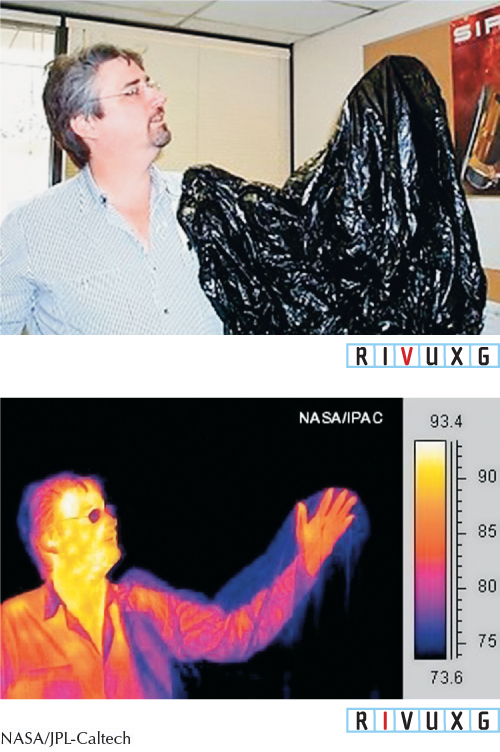
3-15 Infrared and ultraviolet telescopes also use reflectors to collect their electromagnetic radiation
As with radio and microwave telescopes, infrared and ultraviolet telescopes are all reflectors. Indeed, using suitable CCDs, optical reflecting telescopes can also detect infrared and ultraviolet photons with wavelengths near visible light. The most sensitive infrared-detecting CCDs must be cooled to prevent the heat (and, hence, infrared photons) of the telescope from overwhelming the infrared radiation received from objects in space.
95
Margin Question 3-9
Question
Where in a typical house would infrared detectors indicate the most activity?
Because water vapor is the main absorber of infrared radiation from space, locating infrared observatories at sites of low humidity can overcome much of the atmosphere’s hindrance. For example, the summit of Mauna Kea is exceptionally dry (most of the moisture in the air is below the height of this volcano). Infrared observations are made on the summit by the primarily optical-wavelength Subaru and two Keck telescopes, as well as by NASA’s 3-m Infrared Telescope Facility (IRTF).
The best way to avoid the obscuring effects of water vapor is to place a telescope in orbit around Earth. The 1983 Infrared Astronomical Satellite (IRAS) and the Infrared Space Observatory (ISO) launched in 1995 (both now out of service), and Hubble Space Telescope’s Near Infrared Camera and Multi-Object Spectrometer (NICMOS) and the Spitzer Space Telescope launched in 2003 (Figure 3-36), among others, have done much to reveal the full richness and variety of the infrared sky. Spitzer is the infrared equivalent to HST, one of NASA’s Great Observatories. In 2010, NASA began flying a telescope called SOFIA (Stratospheric Observatory for Infrared Astronomy) in a modified Boeing 747. At altitude, a giant door in the side of the aircraft slides open and the telescope observes the night sky high above water vapor in the atmosphere. Perhaps the most exciting recent development in infrared astronomy is design and ongoing construction of the 6.5-m-diameter James Webb Space Telescope. This new telescope is scheduled for launch in 2018.
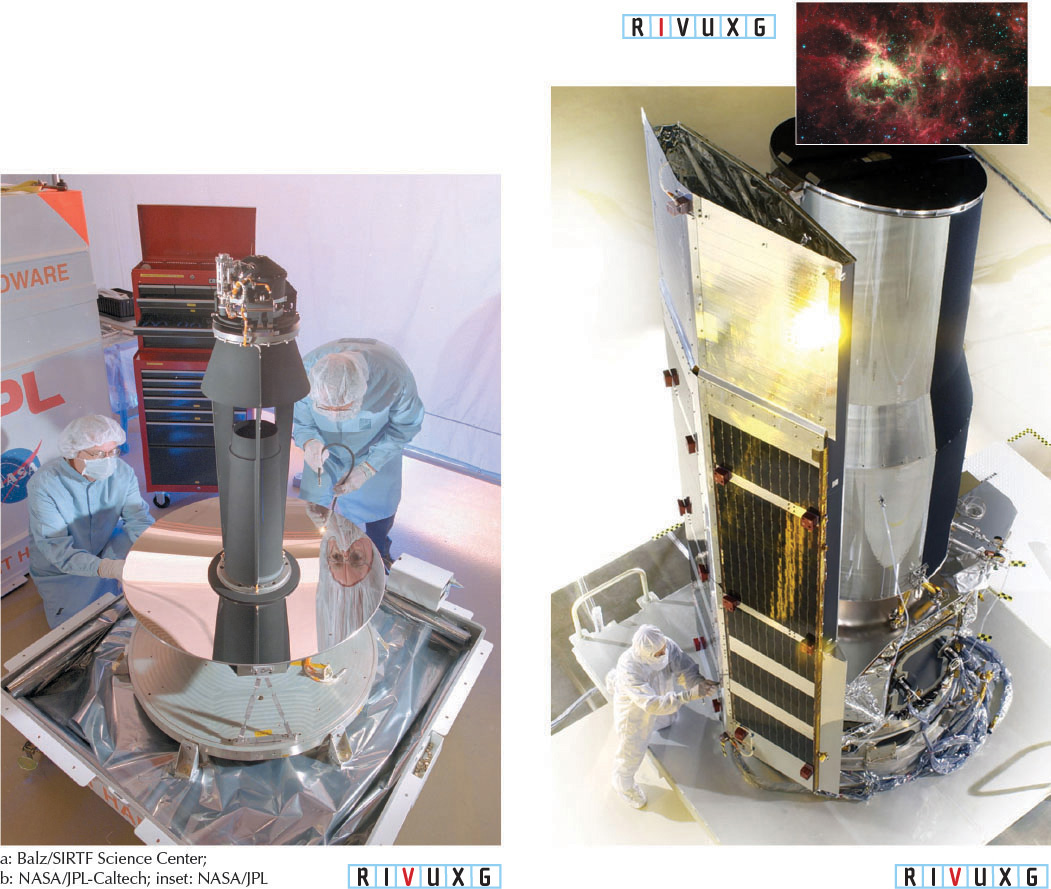
96
Infrared telescopes detect radiation from small bodies in the solar system, as well as from the bands of dust in our Galaxy, newly formed stars, the dust disks around stars at various stages of their evolution, and the most distant galaxies, whose radiation arrives here primarily at infrared wavelengths, among other infrared-emitting objects. Astronomers have located more than a half-million infrared sources in the sky, most of which are invisible at optical wavelengths. As with radio waves, some infrared radiation passes through interstellar clouds of dust and gas, allowing astronomers to see, for example, individual stars at the center of our Galaxy some 245 trillion km (153 trillion mi) away (Figure 3-37).
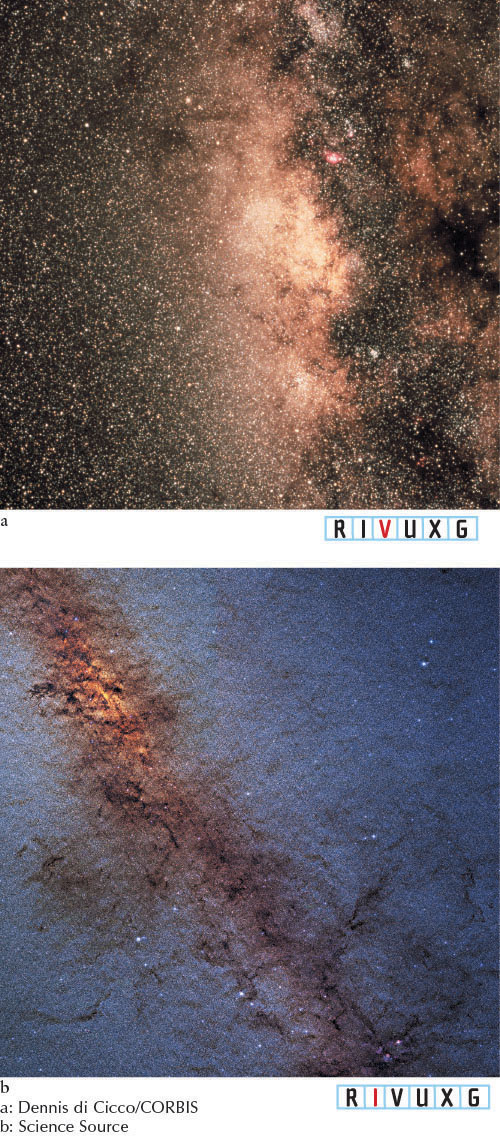
During the early 1970s, ultraviolet astronomy got off the ground—literally and figuratively. Both Apollo and Skylab astronauts used small telescopes above Earth’s atmosphere to give us some of our first views of the ultraviolet sources in space. Small rockets have also been used to place ultraviolet telescopes briefly above Earth’s atmosphere. A typical ultraviolet view is shown in Figure 3-32b.
Some of the finest early ultraviolet astronomy was accomplished by the International Ultraviolet Explorer (IUE), which was launched in 1978 and functioned until 1996. The space shuttle was transformed into an orbiting observatory twice in the 1990s, carrying aloft and then returning to Earth three ultraviolet telescopes. In 1992, the Extreme Ultraviolet Explorer (EUVE) was launched. As with infrared observations, ultraviolet images reveal sights previously invisible and often unexpected. Many objects in space emit ultraviolet radiation that astronomers can use to study the chemistries of these cosmic bodies. Therefore, in 1999, astronomers launched the Far Ultraviolet Spectroscopic Explorer (FUSE), which worked through 2007, and the Galactic Evolution Explorer (GALEX), which is in operation today. These latter two telescopes provided information about such things as how much deuterium (hydrogen nuclei with one neutron) was created when the universe formed, the location of particularly hot interstellar gas and dust, and the stellar and chemical evolution of galaxies.
Telescopes dedicated to studying the Sun have observed it from the ground since 1941, and solar telescopes have studied it continuously from space since 1984. Since 1995, the Solar and Heliospheric Observatory (SOHO) has investigated the Sun from space with ultraviolet detectors. More recent orbiting observatories include STEREO (Solar TErrestrial RElations Observatory), launched in 2006, and SDO (the Solar Dynamic Observatory), launched in 2010. These observatories observe the Sun’s outer layers rising and sinking, along with a wide range of energetic activity emanating from it. These telescopes show us breathtaking ultraviolet images and movies, some in 3D, of our star. In Chapter 10 we will discuss these observations and their physical origins.
97
3-16 X-ray and gamma-ray telescopes cannot use normal reflectors to gather information
X-rays and gamma rays from space interact strongly with the particles in Earth’s atmosphere, preventing these dangerous radiations from reaching our planet’s surface. Therefore, direct observations of astronomical sources that emit these extremely short wavelengths must be made from space. Astronomers got their first look at X-ray sources during brief rocket flights in the late 1940s. Several small satellites, launched during the early 1970s, viewed the sources of both X-rays and gamma rays in space, revealing hundreds of previously unknown objects, including several black holes (see Chapter 14). X-ray telescopes have also been carried on space shuttle missions. The insets in Figure 3-38 show how different our Sun appears when seen through X-ray and visible-light “eyes.”
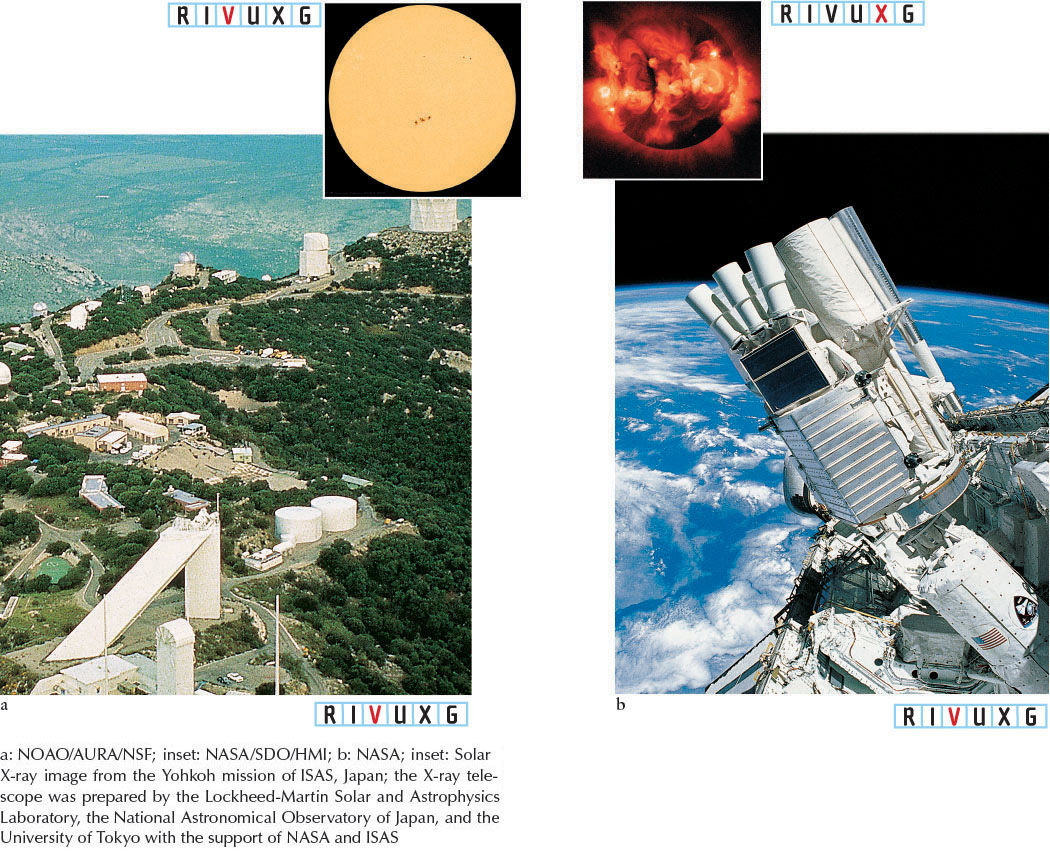
X-ray photons are tricky to collect. Because of their high energies, X-rays penetrate even highly polished surfaces that they meet nearly head–on. Therefore, normal reflecting mirrors cannot be used to focus them. Instead, X-ray telescopes are designed to deflect photons at a fairly shallow angle because X-rays that are barely skimming or grazing a surface can be reflected and thereby focused. This process is analogous to skipping a flat rock on water; throw it at a steep angle and it immediately sinks; throw it at a shallow angle and it will skip off the surface. Figure 3-39 shows the design of such “grazing incidence” X-ray telescopes.
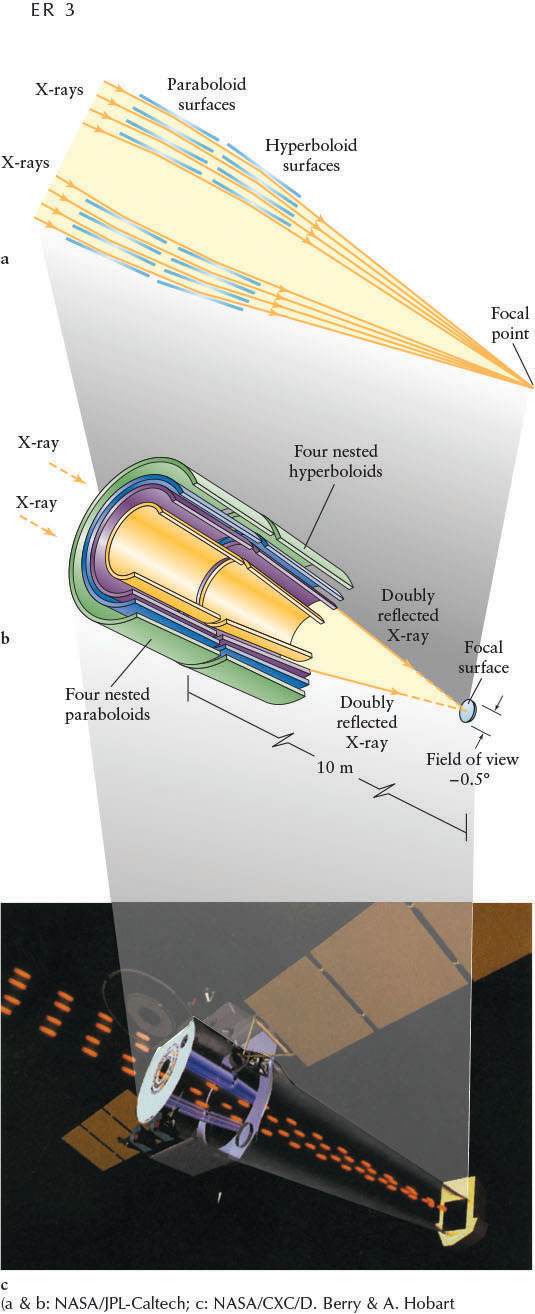
98
After being focused, X-rays are detected in several ways. As at infrared, visible, and ultraviolet wavelengths, CCDs can detect these photons. Other devices, called scintillators, detect the visible light created as X-rays pass through them. Still other instruments, called calorimeters, detect the heat generated by X-rays passing through the detector.
At least seven X-ray telescopes are orbiting Earth today. Among them, the Chandra X-ray Observatory, a NASA Great Observatory named after the Nobel laureate astronomer Subrahmanyan Chandrasekhar (1910–1995), provides images with better than 1″ resolution, and the European Space Agency’s XMM-Newton has 6″ resolution. Other X-ray telescopes are carried high into the atmosphere by balloons. The balloons float at altitudes up to 40 km (25 mi) above Earth’s surface and often stay up for several weeks. Whereas low-energy X-rays do not penetrate that far into the atmosphere, higher-energy X-rays do, giving these balloon-borne telescopes a wide range of objects to study.
More than 10,000 X-ray sources have been discovered all across the sky. Among these are planetary atmospheres, stars (see the Sun in Figure 3-38), stellar remnants, vast clouds of intergalactic gas, jets of gas emitted by galaxies, black holes, quasars, clusters of galaxies, and a diffuse X-ray glow that fills the universe.
The electromagnetic radiation with the shortest wavelengths and the most energy are gamma rays. In 1991, the Compton Gamma-ray Observatory, also a NASA Great Observatory, was carried into orbit by the space shuttle. Named in honor of Arthur Holly Compton (1892–1962), an American physicist and Nobel laureate who made important discoveries about gamma rays, this orbiting observatory carried four instruments that performed a variety of observations, giving us tantalizing views of the gamma-ray sky until the telescope failed in 2000. At least 4 gamma-ray telescopes, including the SWIFT Gamma-Ray Burst Mission and the Fermi Large Area Telescope, are presently operating in space, and several have been flown on balloon missions.
Gamma-ray telescopes, such as the VERITAS and MAGIC arrays, are also operating here on Earth. As we noted earlier, gamma rays do not reach Earth’s surface from space. However, when these photons strike atoms in Earth’s atmosphere, they cause cascades of gas particles to rush earthward at high velocities. As these particles descend into the atmosphere, they give off visible and UV radiation called Cherenkov radiation. This radiation travels predictable angles from the particles that emit it and therefore detecting it enables astronomers to calculate from what direction the original gamma ray came.
99
Several thousand gamma-ray sources have been discovered. However, gamma rays are too powerful even for grazing incidence telescopes. Therefore, astronomers have devised other methods of detecting them and determining their origin. These include absorbing them in crystals; allowing them to pass through tiny holes called collimators whose directions are well determined; and using chambers in which the gamma rays transform into electrons and positrons (positively charged electrons), leaving a track whose direction can be determined. These techniques are not nearly as precise as those used in other parts of the spectrum, and the best resolution gamma-ray instruments are only accurate to about 5′.
We now have telescopes with which we can see the energy in the universe from virtually all parts of the electromagnetic spectrum (Figure 3-40). Telescopes provide us with more than just stunning images of objects in space. They also provide information about the chemistry of stars and interstellar gas and dust, the motion of stars and galaxies toward or away from us, whether stars are rotating, the formation of galaxies and their groupings in the universe, and the expansion of the universe and its fate, among myriad other things. We will explore how we get this information when we study the various objects in space.
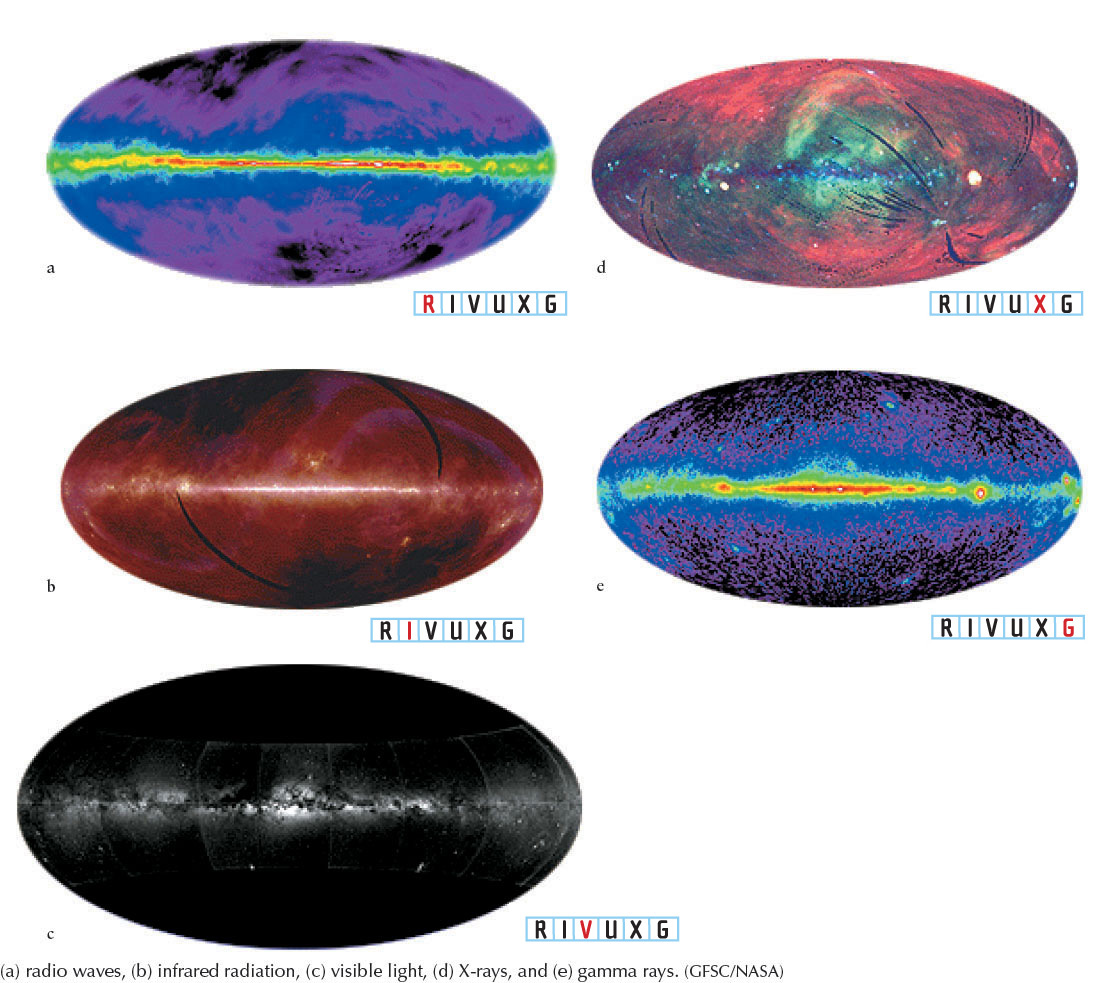
 Survey of the Universe in Various Parts of the Electromagnetic Spectrum By mapping the celestial sphere onto a flat surface (like making a map of Earth), astronomers can see the overall distribution of strong or nearby energy sources in space. The center of our Galaxy’s disk cuts these images horizontally in half. Because most of the emissions shown in these images fall in this region, we know that most of the strong sources of various electromagnetic radiation as seen from Earth (except X-rays) are in our Galaxy: (a) radio waves, (b) infrared radiation, (c) visible light, (d) X-rays, and (e) gamma rays.
Survey of the Universe in Various Parts of the Electromagnetic Spectrum By mapping the celestial sphere onto a flat surface (like making a map of Earth), astronomers can see the overall distribution of strong or nearby energy sources in space. The center of our Galaxy’s disk cuts these images horizontally in half. Because most of the emissions shown in these images fall in this region, we know that most of the strong sources of various electromagnetic radiation as seen from Earth (except X-rays) are in our Galaxy: (a) radio waves, (b) infrared radiation, (c) visible light, (d) X-rays, and (e) gamma rays.
Until recently, photons were the only sources of detailed astronomical information that we had. However, in the past four decades, physicists have built detectors for waves and particles whose nature is not electromagnetic. Chapters 10 and 14 discuss two of these devices: neutrino detectors and gravity wave detectors.
100
3-17 Frontiers yet to be discovered
Before the twentieth century, astronomers were like the blind men in the fable who are trying to describe an elephant. Their perceptions were piecemeal: We could describe parts of the universe but not the whole. Our ancestors did not have the technology that could enable them to see the big picture. However, we are beginning to see it, and, as you will learn in the chapters that follow, our understanding of the cosmos is therefore increasing dramatically. A vast amount of observational information remains to be gathered. Indeed, literally every planet, moon, piece of interplanetary debris, star, stellar remnant, gas cloud, galaxy, quasar, cluster of galaxies, and supercluster of galaxies has a story to tell. Observational astronomy is so new an activity that we are still making new and often unexpected discoveries almost daily. There is still a lot to discover about the elephant.